Chinese Name: 老舍茶馆 Pronunciation: Lǎoshě Cháguǎn
Building Time: 1988
Recommended Visiting Hours: 3-4 Hours
Occupied Area: More than 2,600 square meters
Address: Building 3, Zhengyang Market, Qianmen West Street, Xicheng District, Beijing, China
Building Function: Showing and carrying forward Chinese tea culture and traditional Chinese performing arts
| Shows | Ticket Fee |
| Pingshu | 120 yuan |
| Beijing-style Drum Songs | 80/120/160/200 yuan |
| Beijing-style Variety Show | 188/238/388/588 yuan |
| Cross Talk | 80/120/180/220 yuan |
1. Pingshu or pinghua refers to the traditional Han Chinese performing art of storytelling with no musical accompaniment. It is better known as pingshu in northern China and pinghua in southern China.
2. Children under 1.2 meters can enjoy free tickets but no seats.
| Sites & Shows | Opening Hours/Business Hours | |
| Sihe Teahouse (2nd Floor) | 10:00-23:00 | |
| Beijing’s Tea Culture Product and Service Experiencing and Selling Area (2nd Floor) | 10:00-22:00 | |
| Yi Yuan (2nd Floor) | Pingshu | 14:30-16:30 (Saturday) |
| Beijing-style Drum Songs | 14:30-16:30 (Sunday) | |
| Pinzhen Pavilion (3rd Floor) | 10:30-14:00; 17:00-21:30 | |
| Performance Hall (3rd Floor) | Variety Show | 19:50-21:20 |
| Cross Talk | 16:00-18:00 (Monday-Friday) 16:30-18:00 (Saturday/Sunday) 14:00-15:30 |
|
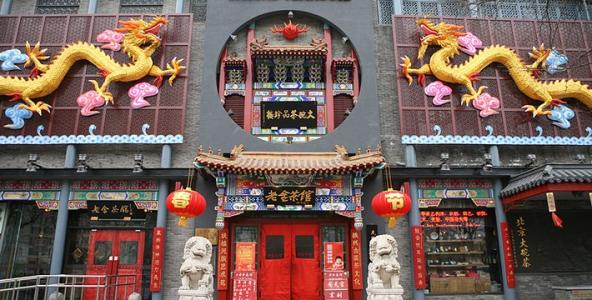
Laoshe Teahouse was founded in 1988, which was formerly known as Qianmen Dawancha (“Dawancha” in Chinese refers to “a big bowl of tea”). It was named after Mr. Lao She (a Chinese people’s artist born in Beijing) and his famous drama Teahouse, but Mr. Lao She has nothing to do with Laoshe Teahouse.
Located at the southwest of Tian’anmen Square and adjacent to Beijing’s ancient commercial street – Dashilar, Laoshe Teahouse covers a business area of more than 5,000 square meters. There are three floors inside Laoshe Teahouse, which comprises six business areas, namely New Beijing-flavored Tea Restaurant, Beijing’s Tea Culture Product and Service Experiencing and Selling Area, Yi Yuan, Sihe Teahouse, Pinzhen Pavilion (“pinzhen” means “savoring the delicious food”), and Performance Hall.
What’s more, it also comprises three public welfare programs. They are Old Erfen Dawancha Stall (“Erfen” equals to 0.02 yuan), Beijing Opera Box Office for Theatregoers, and Old Beijing Traditional Commercial Museum.
Laoshe Teahouse follows the principle of “revitalizing Chinses tea culture and fostering the flower of national art” all the time. Up to now, it has become a teahouse culture center which is integrated with six traditional forms of Beijing teahouse, i.e., story-telling teahouse, banquet teahouse, tea-drinking teahouse, big teahouse, wayside teahouse, and opera-performing teahouse.
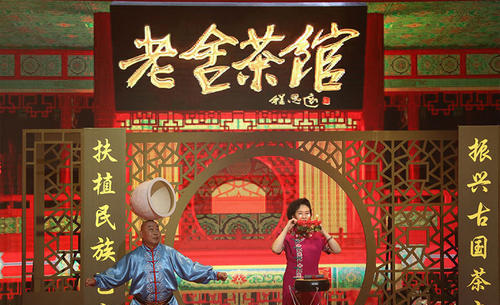
It also involves Beijing tea culture, traditional opera culture, and culinary culture and includes four major operation forms of tea-related service, cultural performance, specialty catering, and tea-related gift.
Since 1988, Laoshe Teahouse has received more than 180 foreign leaders and high-ranking government officials from over 80 countries and more than 7 million guests from home and abroad, such as, Henry Kissinger, the former American Secretary of State.
Now, Laoshe Teahouse holds a total of 16 chain stores nationwide and acquires lots of titles. It is an AAA National Tourist Attraction and a National Cultural Industry Demonstration Base. It is also praised as a window for exhibiting national cultural treasures, a bridge for connecting the friendships between foreigners and Chinese people, a visiting card of Beijing, and a Beijing-flavored cultural landmark.

In 1979, the founder of Dawancha Laoshe Teahouse, Mr. Yin Shengxi, led educated youths who returned to the city from the rural areas to sell big bowls of tea at Qianmen Street in Beijing. The price of a big bowl of tea was only 0.02 yuan to respond to the reform and opening-up policy.
In 1987, Beijing Dawancha Commercial Trading Company was founded.
In 1988, Beijing Dawancha Commercial Trading Company devoted all its efforts and funds to the establishment of the first cultural teahouse after the reform and opening-up at the original location, namely Laoshe Teahouse.
In 2005, the National Museum of China collected over 300 pieces of historical materials related to Mr. Yin Shengxi.
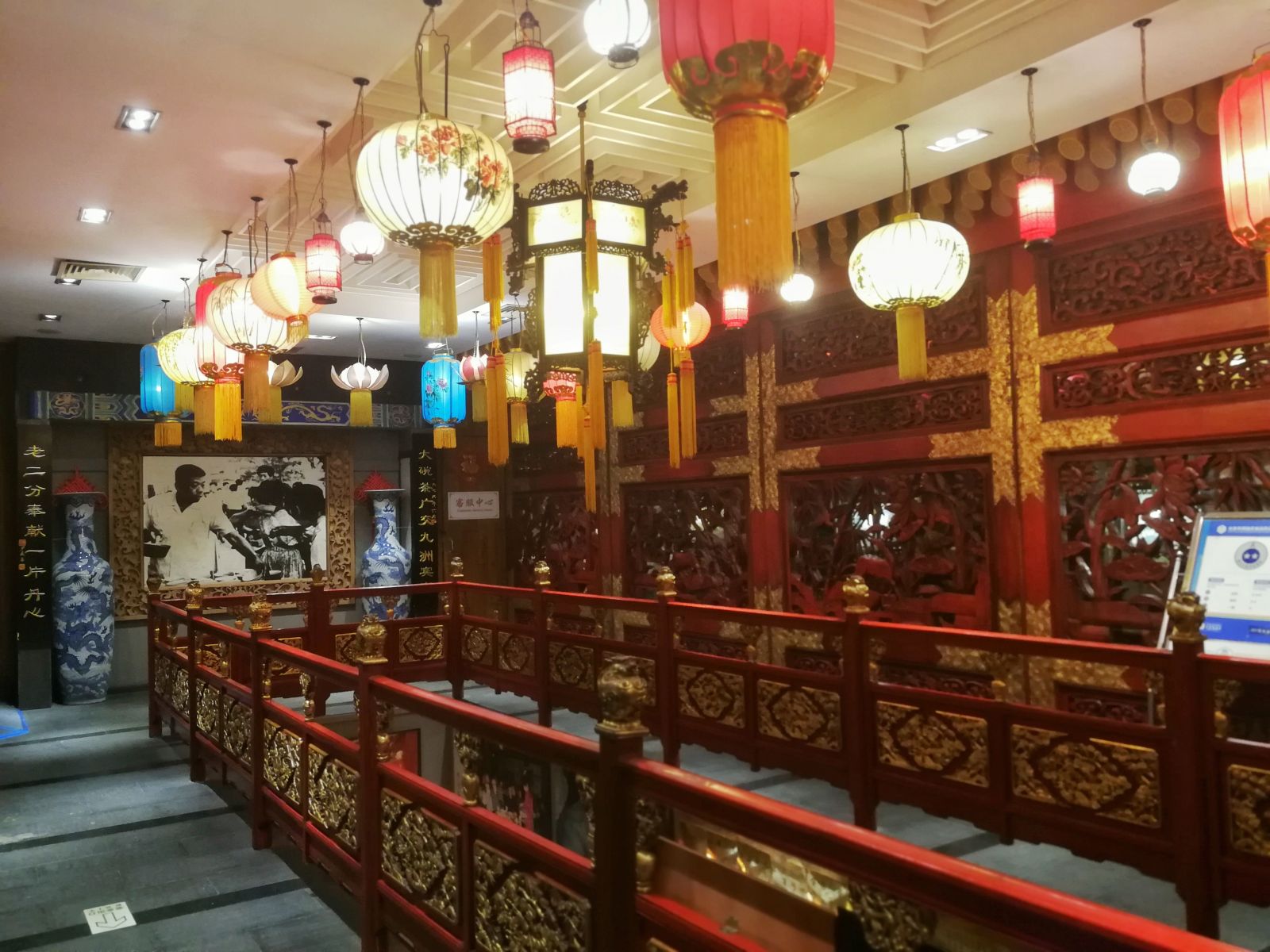
Laoshe Teahouse presents the traditional Chinese architectural design on the whole. Performance Hall has an antique-flavored decoration design and astylar design. There are palace lanterns hanging on the roof and back-rest chairs. Yi Yuan adopts the design of the theatrical stage of the mansion of the prince, in which the stage is surrounded by short rails and the room is decorated with painted beams.
Sihe Teahouse in Laoshe Teahouse takes Beijing Siheyuan, a traditional form of residence in the north of China, as the model and integrates the architectural characteristics in the south. The main house is located at the north. The side houses adjoining the main house are respectively positioned at east and west symmetrically. The east side houses and west side houses are symmetrical. Connecting the houses in the north, east and west are beautifully decorated with pathways.
Handeng Drum is an ancient performance form of singing (“Handeng” means “holding a lantern support in the mouth”). The performer holds the lantern support with burning candles in the mouth when singing and ensures that the candles will not fall from the lantern support.
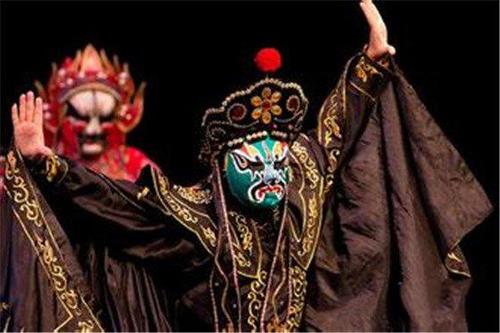
Sichuan Opera Face Changing is a unique technique of Sichuan Opera performance, which is similar to magic. The most attractive scene is the performer changing his/her face 14 times in a minute under the cover of dance movements. The purpose of changing face is to show different emotions of the characters, turning those intangible moods into concrete expressions. Due to its uniqueness and importance in Chinese performance arts, this technique is listed as the Level-two National Secret.
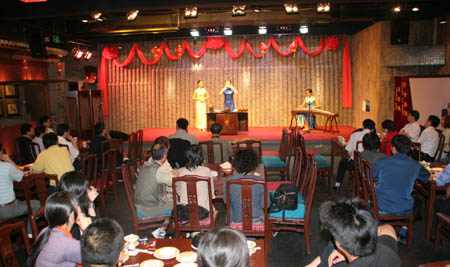
Kung fu, also known as Chinese martial art, has been popular in western countries since a series of action movies with Bruce Lee as the leading role were released. In the Collins Dictionary, Kung fu is defined as a Chinese way of fighting in which people use only their bare hands and feet. That is why it is so attractive and mysterious. However, that is a misunderstanding of Kung fu. In China, Kung fu is not only a practical skill to battle with rivals but also a spiritual culture reflecting people’s fighting spirit.
If you want to experience Chinese tea culture, then Sihe Teahouse is the place you cannot miss. Here, you can have a quick meal, drink tea, and enjoy guzheng performance (“Guzheng” is a plucked instrument) and a tea art performance. The most attractive activity is to learn tea art, for which the teahouse provides training service.
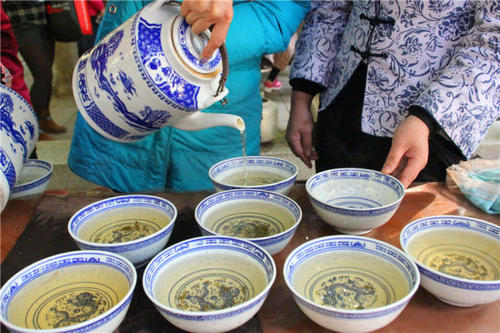
In front of Laoshe Teahouse, there is an Old Erfen Dawancha Stall. It reminds people of its original aspiration – leading Chinese people to start up business in response to the policy of reform and opening-up. Today, this policy has been implemented for over 40 years and helps the Chinese people to have a better life.
If you want to experience performances as more as possible, you’d better go to Laoshe Teahouse in the afternoon.
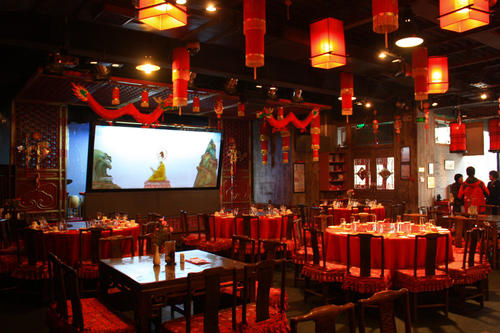
The New Beijing-style Tea Restaurant on the first floor was opened to the public in 2006. It covers an area of about 330 square meters in which the area of the stage is 21 square meters. The guests can appreciate delicious old Beijing cuisines including various snacks and experience specialty tea dishes. What’s more, when having a meal, the guests can also watch the shadow plays for free at 12:00, 13:00, 17:30, 18:30, and 19:30.
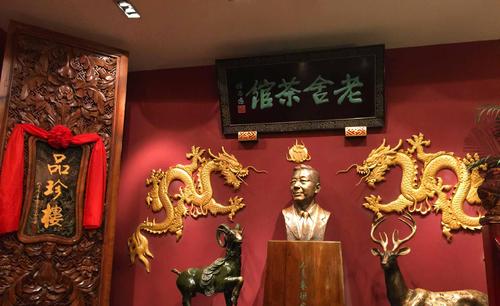
Pinzhen Pavilion is noted for Chinese traditional main courses. It mainly provides royal tea dishes and a minor Manchu-Han Banquet with 64 dishes. Manchu-Han Banquet is a royal feast originated from the Qing Dynasty (1636-1912), which comprises 54 dishes from the southern regions and 42 dishes from the northern regions, which are dishes of Han nationality, and 12 dishes of Manchu Minority. The minor Manchu-Han Banquet only contains half of that.
Sihe Teahouse → Beijing’s Tea Culture Product and Service Experiencing and Selling Area → Pingshu/Beijing-style Drum Songs → Cross Talk → New Beijing-style Tea Restaurant/ Pinzhen Pavilion → Variety Show
Take bus 2, 5, 8, 20, 22, 48, 59, 66, 67, 82, 93, 120, 141, 332, 599, Tourism Line 1 or Tourism Line 2 and get off at Qianmen Station. And then, walk northeast for 220 meters along the Meishijie(Meishi St.), turn front-left, walk 20 meters, turn left, walk about 200 meters to the destination.
Take bus 9, 22, 44, 67, 332 or 901 Express and get off at Qianmen West Station.
Take Metro Line 2 and get off at Qianmen Station (Exit C). Then walk about 700 meters to the west.
Chinese: 请带我去老舍茶馆。English: Please take me to Laoshe Teahouse.
If you go to Laoshe Teahouse from the center of Beijing (Grand Hyatt Beijing), it takes about 15 minutes (about 20 yuan).
If you go to Laoshe Teahouse from Beijing West Railway Station, it takes about 15 minutes (about 20yuan).
If you go to Laoshe Teahouse from Beijing South Railway Station, it takes about 20 minutes (about 25 yuan).
If you go to Laoshe Teahouse from Beijing Capital International Airport, it takes about 1 hour (about 110 yuan).
If you go to Laoshe Teahouse from Beijing Daxing International Airport, it takes about 1 hour (about 170yuan).
